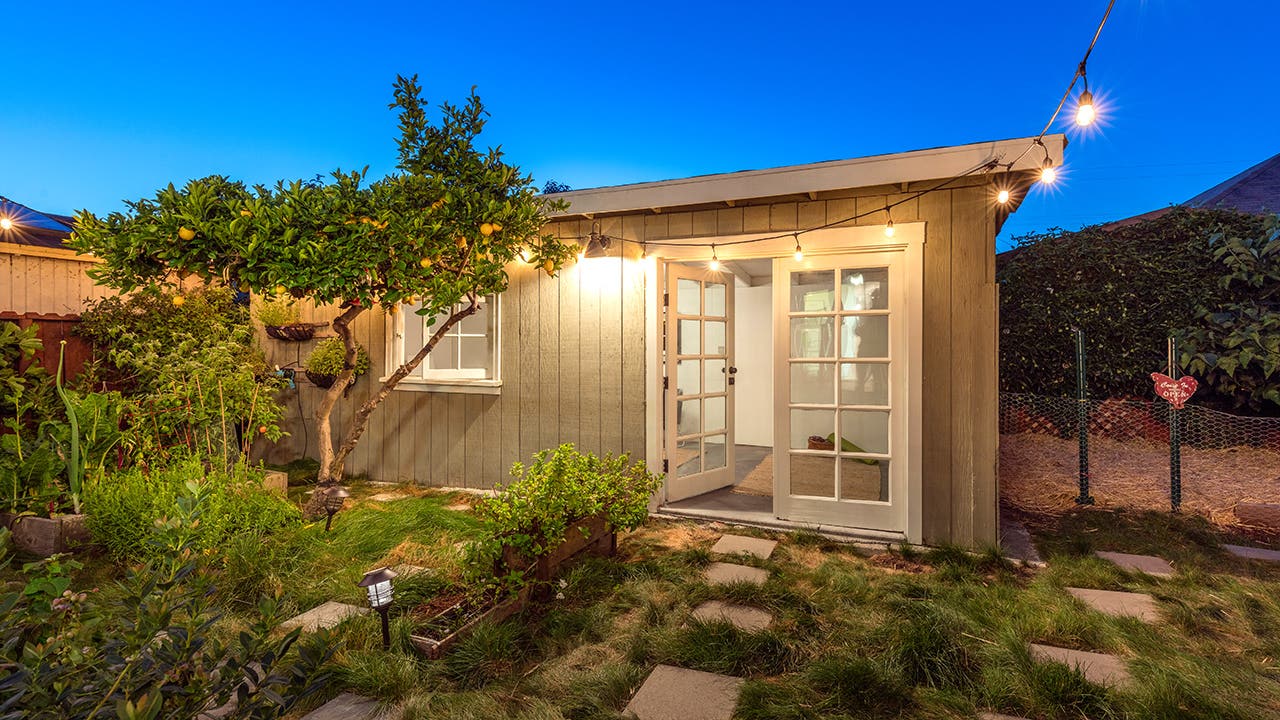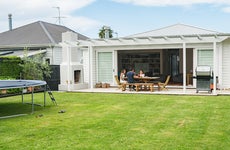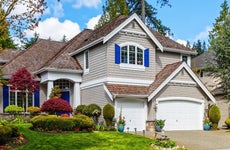Tiny homes: Are they worth it?

The Bankrate promise
At Bankrate, we strive to help you make smarter financial decisions. To help readers understand how insurance affects their finances, we have licensed insurance professionals on staff who have spent a combined 47 years in the auto, home and life insurance industries. While we adhere to strict , this post may contain references to products from our partners. Here's an explanation of . Our content is backed by Coverage.com, LLC, a licensed entity (NPN: 19966249). For more information, please see our .
Although tiny homes have been a fixture of American life since the 1800s, they have never been more popular than they are now. These low-cost, energy-efficient alternatives to traditional homes can open the door to homeownership for everyone, from young millennials saving for their first home to older adults looking to downsize. Tiny-home owners tend to have less debt and a smaller carbon footprint than others, and more than half of them are female. Bankrate explores the reasons for their popularity and the challenges of tiny living for those drawn to this unique lifestyle.
Types of tiny homes
Tiny houses come in various types, each catering to diverse lifestyles and preferences. The traditional tiny house on wheels (also called a THOW) is mobile and offers flexibility, ideal for nomadic homeowners. Converted shipping containers provide a sustainable option, repurposing industrial materials. Tiny cabins have a rustic charm, often nestled in natural settings. Modern modular tiny homes are customizable and efficient, allowing for easy expansion when needed. Treehouses, elevated tiny dwellings, offer a whimsical living experience. In addition, there are minimalist micro-apartments in urban settings that maximize space usage. These diverse types of tiny houses reflect a growing trend toward sustainable, efficient and adaptable living spaces.
How much is a tiny house?
The average cost of a tiny home can vary widely based on factors such as size, location and customization. Generally, a basic tiny house might cost between $20,000 to $50,000, while more elaborate or custom-built options can exceed $100,000. Prices fluctuate based on individual choices and market conditions, making research crucial for those considering the affordability of a tiny home.
This table can help you estimate the cost to build a house for both tiny homes and traditional homes.
| Expense | Tiny home estimate | Traditional home estimate |
|---|---|---|
| Land/parking | Varies depending on state and size of the lot. If you’re building on wheels, you’ll need a large trailer that costs between $4,500 and $9,000. (HomeAdvisor) Parking costs for a tiny house on wheels (THOW): $300-$800/month (ridingtiny.com) |
Varies depending on state and size of the lot. According to the National Association of Home Builders (NAHB), the average cost of land is $53,000. Parking: NA |
| Building permits and taxes | Varies depending on location, but you can expect to spend between $400 and $2,300. (Bob Vila) | Permits cost $500-$3,000; taxes vary based on location (Homeguide) |
| Foundation | $5,000 to $8,000 (Bob Vila) | $9,233 (homeadvisor) |
| Home systems (electrical, HVAC, plumbing) | $250-$5,000 for electrical; $1,000-$2,500 for HVAC (Bob Vila); $1,500-$4,000 for plumbing (UnitedTinyHomes) | $30,000-$75,000 (newhomesource) |
| Exterior costs (roof, siding, windows) | Combined with interior costs, expect exterior costs to run between $14,050 and $60,000. (HomeAdvisor) | $40,000 (todayshomeowner) |
| Interior costs (furniture, flooring, insulation) | Combined with exterior costs, expect interior costs to run you between $14,050 and $60,000. (HomeAdvisor) | $50,000-$100,000 (Quickenloans) |
| Home insurance | $600-$1,000 per year (Quicken) | $1,759 per year for $250,000 in dwelling coverage (Bankrate) |
| Appliances | $400-$4,500 (Greatlakestinyhome) | $10,875 (Homeadvisor) |
| Energy/electric costs | $50 per month (ridingtiny) | $172 per month (energystar) |
It’s important to consider the cost of insurance when looking at how much the cost is for a tiny house. Insuring your tiny home may be more costly than the average cost of homeowners insurance for traditional homes. Many tiny homes are built with a trailer hitch to facilitate travel. Moving a tiny home increases the risk of damage, and as a result, tiny-home owners may pay higher home insurance premiums.
If you’re looking for homeowners insurance for your tiny home, note that you may have to purchase a mobile or manufactured home insurance policy for it. Depending on your location, you may also need to consider purchasing flood insurance.
Talking with a licensed insurance agent from one of the best homeowners insurance companies on the market can help you understand what type of policy would work best for you.
What are the financing options and challenges for a tiny home?
Financing a tiny home presents unique options and challenges. Traditional mortgages may be difficult to obtain due to the unconventional nature of tiny homes. Some homeowners opt for using personal savings or crowdfunding to fund their project. There are an increasing number of specialized lenders offering tiny home loans, catering to this growing market. Challenges include zoning restrictions and lack of standardized building codes, which may impact loan approvals. The growing popularity of tiny homes is prompting new financial solutions geared toward supporting those with tiny homes.
Tiny house statistics
While tiny homes are generally cheaper than traditional houses, costs associated with them can still stack up. Additionally, the minimalist lifestyle, while great for travel and the environment, may not be for everyone. It may be wise to consider the following statistics before deciding whether or not to purchase a tiny home.
- To be considered a tiny home, a structure must have a ceiling height of no less than 6’4″ in bathrooms and kitchens, while the rest of the house must have ceilings of at least 6’8″. (GreatLakesTinyHomes)
- The smallest tiny homes are around 60 square feet. (GreatLakesTinyHomes)
- A tiny home uses about three to four kW of power per day, while a traditional home uses an average of 26-33 kW daily. (Ecobee)
- Residents of tiny homes have an ecological footprint that is 45 percent lower than those in traditional homes. (GreenAmerica)
- The states with the most tiny homes are California, Florida and Colorado. (BusinessInsider)
- 60% of tiny house owners have no credit card debt. (Tiny House Society)
- 55% of tiny house owners have more savings than the average homeowner. (Tiny House Society)
What are the challenges of moving into a tiny home?
Moving into a tiny home can be an appealing idea, but the move does come with challenges. Potential dwellers must navigate obstacles, starting with the fact that these tiny buildings are not accepted housing options in some areas. Here are some pros and cons for individuals to consider when they undertake tiny home living.

Pros
- Eco-friendly, with a smaller environmental footprint
- Allow for a simplified and less cluttered lifestyle
- Increased mobility, especially for those who have tiny homes on wheels

Cons
- Zoning and legal hurdles possible
- Small homes mean increased space constraints
- Accessing utilities can be a challenge in remote locations
What are the restrictions regarding where you can live in a tiny home?
Tiny home dwellers often face restrictions on where they can live due to zoning laws and building codes. Many municipalities have minimum square footage requirements for residences, which tiny homes may not meet. Some areas strictly regulate accessory dwelling units (ADUs) or require specific foundation types, limiting the acceptance of tiny homes on wheels. And not all communities are equipped to handle off-grid living, which can pose challenges for those seeking a more remote lifestyle. Navigating these restrictions requires careful research and consideration of local regulations.
Living off the grid
A simplified life off the grid—i.e., away from municipal utilities—is appealing to many people and often goes hand-in-hand with a desire to explore the world of tiny homes. For many individuals, this moves them toward life as a homesteader, which often includes generating their own power, growing their own food and using the amenities of modern life as little as possible. Here are some of the factors that come into play in this type of lifestyle:
- Eco-friendly living: Many tiny homeowners are concerned about the climate crisis and want to avoid over-consumption. In fact, a tiny home uses only about 7 percent of the energy that a traditional house uses, making them far more environmentally friendly.
- Wallet-friendly living: The median monthly mortgage payment for a traditional home is $2,208, a sum many millennials can’t afford. Tiny homes, on the other hand, can cost as little as $8,000 total to build, with no need for a mortgage and far less income necessary for day-to-day living costs.
- Homesteading capitals: The largest hub of homesteaders is in Livermore, Colorado, where residents plant their own food, raise chickens, build their own homes and make their own clothes. Saratoga Springs in New York State is an East Coast hotspot for homesteaders.
- Tiny home capitals: If you’re not ready to become a homesteader but are interested in tiny living, Portland, Oregon; Austin, Texas; Los Angeles, California; New York, New York; and Seattle, Washington, all maintain sizable tiny home communities that range from 10 to over 100 tiny homes per community. Currently, the largest tiny home development in the country is in the works in Salida, Colorado and will feature 200 tiny homes for rent.
- Traveling: Some tiny homes are built on a foundation, but many are built as trailers and can be pulled from one location to the next. With a mobile tiny home, you can move from one location to the next with ease.
Is the tiny house cost worth the investment?
Tiny homes aren’t the right choice for everyone. Large families, for example, would have difficulty finding the space they needed in a tiny home. For others, the minimalist life of tiny home living doesn’t fit in with their needs and wishes.
For those seeking a life of financial independence, however, or anyone who wishes a low-impact, low-cost life with a smaller ecological footprint, the tiny house cost may be worth it. Negotiating zoning restrictions and other challenges may be worthwhile in order to end up in a cozy, efficient living space that contains all the essentials but nothing else that isn’t necessary.
In the end, each individual will need to determine their priorities, research their options and decide whether the unique benefits of a tiny home outweigh the potential drawbacks.
What are the resale values of tiny houses?
Unfortunately, tiny homes often do not retain their value the way traditional homes do. In fact, some sources indicate that you should consider your tiny home’s value to be similar to that of an RV or trailer—as an investment that depreciates, rather than increases, in value as the years go by.
This is especially true for tiny homes on wheels. If your tiny home is on land that you own, and is built on a solid foundation, you are more likely to receive a good return on your investment when you go to sell your home. In other words, the value of your tiny home is directly related to its permanence.
Frequently asked questions
-
-
The lifespan of a tiny home is largely determined by the quality of materials and labor that go into its construction. Generally, you can expect a tiny home to last 30-50 years. Location may also play a role, though. If your tiny home is situated in a flood plain, for example, the impact of frequent flooding may shorten its lifespan. A tiny house on wheels may also have a shorter lifespan if it is frequently subject to the wear and tear of being on the road.
-
Tiny homes do not always appreciate in value in the same way that traditional homes do. Tiny homes on wheels tend to be viewed as similar to a recreational vehicle, and therefore they see a depreciated value as the years pass. Even a stationary tiny home is unlikely to appreciate as quickly as a home does. The tiny houses that see the most appreciation are ADUs (accessory dwelling units) that are situated on a property that also includes a traditional dwelling.
-
Tiny homes can have both positive and negative impacts on mental health. On the positive side, the minimalist lifestyle can reduce stress and encourage a sense of simplicity, promoting mental well-being. However, the limited space may pose challenges, potentially leading to feelings of confinement or clutter-related stress. Additionally, issues related to zoning and finding suitable locations may add stressors. Overall, the impact on mental health depends on individual preferences, adaptability and how well the tiny home aligns with the dweller’s lifestyle and psychological needs.
-
Related Articles


Shopping for home insurance? Waiting until you move may cost you money

